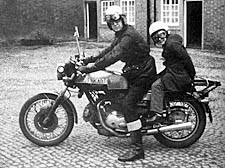
George Seymour takes his six-year-old grandson for a ride on his Ducati motorcycle nicknamed The Duke |
Exorcising the ghost of Miranda’s father
It has taken Miranda Seymour a long time to confront the truth about her father. She speaks to Ruth Gorb about love, cruelty and skeletons
In My Father’s House is published by Simon and Schuster, priced £14.99 order this book
GEORGE Seymour died in 1994. At the end of one of his three obituaries, a friend wrote: “What an extraordinary man. Now we know what Miranda’s next book should be.”
Miranda Seymour, distinguished biographer and novelist, and daughter of George, was appalled at the suggestion.
She was not ready to face the truth about her father’s life, or the pain he had consistently inflicted on her. Now, 12 years on, she has written the book, and she is the keeper of the great house which was the object of her father’s obsessive love. But if she hoped that by writing she would exorcise the past, it has not happened – “Not yet, not yet,” she says.
She seems, sitting in her pretty drawing room in Belsize Park to be a woman who has it all. Elegant, glowingly happy in her recent (third) marriage, she has a clutch of successful books to her name – biographies of Robert Graves, Ottoline Morrell and Henry James. And there is that house in Nottinghamshire, Thrumpton Hall, a place she loves and where she spends a great deal of her life, despite the memories, not least that her father’s love for the House (the capital letter is significant) left no room for her.
She shares the House with her mother now – “there was never any question of her moving. She adores it, after all, she sacrificed herself to it and to my father”, Miranda says.
Who then, was the man who cast such a spell on his family? Reading this remarkable, totally enthralling and painfully personal book, one is moved to laughter as much as tears, but it is an uneasy laughter.
George Seymour seems to have gone beyond the stereotype of the eccentric country squire. In the middle-age he took to wearing black leather and zoomed around the countryside on a motorcycle – a young man riding pillion. He took great pleasure in shocking the village by installing a naked Ethiopian eunuch, Slav, to help in the house. He decided that his wife’s hair, and that of his daughter Miranda, was not to his liking, so they were to wear wigs. Didn’t the teenage Miranda rebel? “If my father said wear a wig, you wore a wig,” she says.
He could be appallingly cruel. On one heartbreaking occasion when a hunt ball house party at Thrumpton Hall was to be filmed, Rosemary Seymour made her entrance in a ravishing new dress, clinging and shimmering with sequins. Her husband’s reaction was violent. In front of his guests, he raged: “Oh my God, dreadful, go and change.” Only recently has Miranda begun to understand why. He could not bear his wife looking alluring. Now it is obvious to her that it was all part of his bisexuality. Something, that even when she started the book, she did not accept.
The clues were all there. The disgust of blatant femininity; the pleasure of having a eunuch in the house; a close relationship with young men.
But Miranda Seymour was so unaware that she was deeply shocked when her editor, on reading the first version of the book, said: “You haven’t confronted what the book is about – your father’s homosexuality.”
What homosexuality, she wondered? She had, she says, pushed it away. It was not the book that made her accept it. It was a relief to say it at last. Did it upset her? Not really.
“But I’m upset when I think of my father at the end of his life,” she says.
“I can’t read about it in the book without crying.”
George Seymour’s end is heart-rending. He loses the young man he loves in tragic circumstances. His grief is terrible to see, and briefly his daughter “felt for him at that moment, something that was close to pain, a stab of love”. All her life, and even now, her feelings for her father are torn in two: “I hate him, I love him,” she writes.
He was, says Miranda Seymour, obsessed with family and rank, although on wonders what he had to worry about – his antecedents, including his wife’s, included Lord Byron, King Charles II, a baron and the odd duke. His daughter says it is indeed complicated, and one of the problems was that he was connected but “not quite there”, whereas his wife was “really grand”.
It was Rosemary Seymour’s confidence in who she was which made her cope so well with the changes in her life.
It is she who is the heroine of the story, and it is she who infuses its intensity. There is no way Miranda Seymour could have written the book without her mother, so she uses her as a literary device.
It was with some trepidation that Miranda showed her mother the book. Her reaction, after a strong whisky, was: “I never had freckles and my nail varnish was never chipped.”
The House is now filled with Miranda’s friends, and her mother has blossomed in their company: “A world she lost when she married my father”.
|



